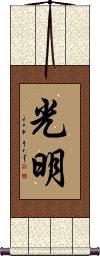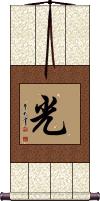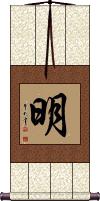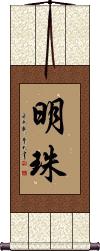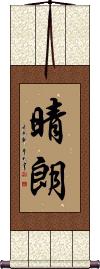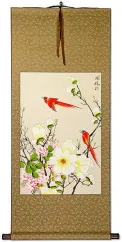Many custom options...
And formats...

Bright in Chinese / Japanese...
Buy a Bright calligraphy wall scroll here!
Personalize your custom “Bright” project by clicking the button next to your favorite “Bright” title below...
Light / Bright and Promising Future
光明 is a nice way to say “light” in Chinese and old Korean Hanja.
This is because the word also suggests a bright future or refers to someone who is very promising (great future potential).
The first character means light or bright.
The second character means bright and clear (in this context).
This word appears in most Japanese dictionaries, but it is not the most common Japanese Kanji word for light (more commonly used for the name Mitsuharu).
In old Korean Hanja, this can also mean brightness or brilliance.
In the context of Buddhism, this means “Light emanating from a Buddha or Bodhisattva, symbolizing their wisdom and compassion.”
Bright and Promising Future
明るい未来 is a Japanese proverb that means “Bright Future.”
It suggests a lot of possibilities and potential awaits in your future. A great gift for a graduate.
The first part of this proverb literally means bright or light. The second part means the future but can also be translated as “the world to come.”
Note: Because this selection contains some special Japanese Hiragana characters, it should be written by a Japanese calligrapher.
Light / Bright / Shine
光 is the simplest way to express “light” in Chinese, Japanese Kanji, and old Korean Hanja.
It can also mean ray or bright. Chinese tend to use a two-character word for light/bright, so this character is probably best if your audience is Japanese. Also, when pronounced Rei, this can be a Japanese female given name.
In the Zen Buddhist context, this is the pure light that everyone possesses at their origin.
Light / Bright
明 means light, bright, clear, clarity, to understand, or wise.
In Chinese, this can refer to the Ming Dynasty (1368-1644) where it can also be the surname Ming.
In Japanese, this can be romanized many different ways when used as surnames or given names. 明 is a partial list of those names: Meishuu, Mei, Min, Myoujin, Myou, Hinata, Haru, Toshi, Tooru, Sayaka, Saya, Satoshi, Asumi, Akera, Akemine, Akesaki, Ake, Akuru, Akiraka, and Akira.
In the Buddhist context, this represents vidyā (knowledge). To expand that, Buddhists understand this to mean bright, clear, enlightenment, wisdom, or to understand. It represents Buddha-wisdom and its revelation; also the manifestation of a Buddha's light or effulgence.
Bright Pearl
This means bright pearl or jewel of great value.
明珠 is a female given name Mingzhu in Chinese or Meishu in Japanese.
Sunny / Clear and Bright
A Bright Future
Incredible 10,000-Mile Flight of the Peng
鵬程萬里 is an ancient Chinese proverb used in modern times to wish someone a long and successful career.
It's really about the 10,000 Flight of the Peng (Peng, also known as Roc is a mythical fish that can turn into a bird and take flight).
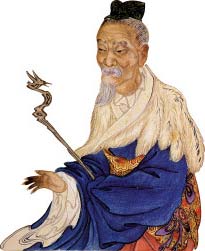
莊子
Zhuangzi or Chuang Tzu
Breaking down each character:
1. Peng or Roc (a kind of bird).
2. Journey (in this case, a flight).
3. 10,000 (Ten Thousand).
4. Li is a unit of distance often referred to as a “Chinese Mile,” though the real distance is about half a kilometer.
Direct Translation: “Peng's Journey [of] 10,000 Li.”
Literal meaning: “The 10,000-Li Flying Range Of The Roc.”
Perceived meaning: “To have a bright future” or “To go far.”
This proverb/idiom comes from the book of Zhuangzi or Chuang Tzu. It tells the tale of a huge fish that could turn into a gigantic bird. This bird was called a “peng” and was many miles long. This legendary size allowed the Peng to fly from the Northern Sea to the Southern Sea in a single bound.
Wishing someone “a Peng's Journey of 10,000 Li” will imply that they can travel far without stopping and will have great success, a long career, and a prosperous future.
This in-stock artwork might be what you are looking for, and ships right away...
Gallery Price: $72.00
Your Price: $39.88
Gallery Price: $300.00
Your Price: $128.88
These search terms might be related to Bright:
100 Years of Happy Marriage
Be Happy
Beautiful Clear Sky
Better to Be Happy Than Rich
Clear Blue Sky
Clever
Clever / Superb / Wonderful
Divine Light
Don't Worry, Be Happy
Extreme / Intense
Faith is the Bird That Feels the Light When the Dawn is Still Dark
Happy
Happy / Laughter / Cheerful Bliss
Happy Birthday
Happy Buddha
Happy Family
Happy Laughter
Happy Marriage
Happy New Year
Initiative / Proactive / Positive
Inner Light / Intelligence
Intense / Serious
Intense / Serious / Deep / Profound
Intuitive Wisdom / Inner Light
Light / Bright
Light / Bright / Shine
Light / Bright and Promising Future
Light of the World
Merciful Heart / the Light From a Buddha Mind
Optimism / Happy With Your Fate
Optimistic
Positive Attitude
Radiance / Rays of Light
Serendipity / Happy Coincidence
Sunny / Clear and Bright
Those Who Understand Are Clever, Those Who Know Themselves Are Truly Wise
Warriors of Light
Yoko / Brilliant / Glorious
Not the results for bright that you were looking for?
Below are some entries from our dictionary that may match your bright search...
| Characters If shown, 2nd row is Simp. Chinese |
Pronunciation Romanization |
Simple Dictionary Definition |
光 see styles |
guāng guang1 kuang rei / re れい |
More info & calligraphy: Light / Bright / Shine(1) light; (2) illumination; ray; beam; gleam; glow; (3) happiness; hope; (4) influence; power; (5) vision; eyesight; (6) (abbreviation) (See 光回線) optical fiber; optical fibre; (female given name) Rei 光明 prabha, light, brightness, splendour, to illuminate. |
天 see styles |
tiān tian1 t`ien tien hiroshi ひろし |
More info & calligraphy: Heaven(1) sky; (2) {Christn} heaven; (3) God; (4) {Buddh} svarga (heaven-like realm visited as a stage of death and rebirth); (5) {Buddh} deva (divine being of Buddhism); (6) top (of a book); (7) sole (of a Japanese sandal); (8) beginning; start; (9) (abbreviation) (See 天ぷら) tempura; (10) (abbreviation) (obsolete) (See 天竺・1) India; (given name) Hiroshi Heaven; the sky; a day; cf. dyo, dyaus also as 提婆 a deva, or divine being, deity; and as 素羅 sura, shining, bright. |
明 see styles |
míng ming2 ming meishuu / meshu めいしゅう |
More info & calligraphy: Light / Bright(1) (ant: 暗) brightness; (2) discernment; insight; an eye (for); (3) (See 明を失う) eyesight; vision; (prefix) (4) (abbreviation) (See 明治) nth year in the Meiji era (1868.9.8-1912.7.30); (surname) Meishuu vidyā, knowledge. ming means bright, clear, enlightenment, intp. by 智慧 or 聰明 wisdom, wise; to understand. It represents Buddha-wisdom and its revelation; also the manifestation of a Buddha's light or effulgence; it is a term for 眞言 because the 'true word' can destroy the obscurity of illusion; the 'manifestation' of the power of the object of worship; it means also dhāraṇīs or mantras of mystic wisdom. Also, the Ming dynasty A. D. 1368-1644. |
朗 see styles |
lǎng lang3 lang rou / ro ろう |
More info & calligraphy: Lon(surname, given name) Rou bright |
白 see styles |
bái bai2 pai yuki ゆき |
More info & calligraphy: White(1) white; (2) (See ボラ・1) striped mullet fry (Mugil cephalus); (3) (See 科白・1) (spoken) line (in a play, film, etc.); one's lines; (4) {mahj} white dragon tile; (5) {mahj} winning hand with a pung (or kong) of white dragon tiles; (6) (abbreviation) (rare) (See 白耳義・ベルギー) Belgium; (7) (abbreviation) (archaism) (See 白人・1) white person; Caucasian; (female given name) Yuki White, pure, clear; make clear, inform. |
翌 see styles |
yì yi4 i asuka あすか |
bright; tomorrow (prefix) the following; next; (female given name) Asuka |
光明 see styles |
guāng míng guang1 ming2 kuang ming kanmyon クァンミョン |
More info & calligraphy: Light / Bright and Promising Future(1) bright light; (2) hope; bright future; (3) {Buddh} light emanating from a buddha or bodhisattva, symbolizing their wisdom and compassion; (place-name) Gwangmyeong (South Korea) v. last entry. |
明珠 see styles |
míng zhū ming2 zhu1 ming chu meishu / meshu めいしゅ |
More info & calligraphy: Bright Pearl(given name) Meishu bright pearl |
明鏡 明镜 see styles |
míng jìng ming2 jing4 ming ching meikyou / mekyo めいきょう |
More info & calligraphy: Mirror: Beautiful Claritypolished mirror; clear mirror; (personal name) Meikyō a [clear] mirror |
碧碧 see styles |
aoao あおあお |
More info & calligraphy: Bibi |
鮮紅 鲜红 see styles |
xiān hóng xian1 hong2 hsien hung senkou / senko せんこう |
More info & calligraphy: Scarlet / Bright Redscarlet; bright red; (given name) Senkou |
マンバ see styles |
manba マンバ |
More info & calligraphy: Manba |
爐火純青 炉火纯青 see styles |
lú huǒ chún qīng lu2 huo3 chun2 qing1 lu huo ch`un ch`ing lu huo chun ching |
More info & calligraphy: Green Fire |
亮 see styles |
liàng liang4 liang riyou / riyo りよう |
bright; light; to shine; to flash; loud and clear; to show (one's passport etc); to make public (one's views etc) (personal name) Riyou |
倞 see styles |
liàng liang4 liang |
distant; to seek; old variant of 亮[liang4]; bright |
冏 see styles |
jiǒng jiong3 chiung hisashi ひさし |
velvetleaf (Abutilon avicennae), plant of the jute family; bright (personal name) Hisashi |
凞 see styles |
xī xi1 hsi |
bright; splendid; glorious |
囧 see styles |
jiǒng jiong3 chiung |
(archaic) light, bright (variant of 冏[jiong3]); (since c. 2005) (slang) emoticon signifying embarrassment, shock, helplessness etc |
彩 see styles |
cǎi cai3 ts`ai tsai midori みどり |
(bright) color; variety; applause; applaud; lottery prize (female given name) Midori coloring |
敫 see styles |
jiǎo jiao3 chiao |
bright; glittery; Taiwan pr. [jiao4] |
昑 see styles |
qǐn qin3 ch`in chin |
bright |
昣 see styles |
zhěn zhen3 chen |
(literary) bright |
昪 see styles |
biàn bian4 pien |
(literary) (of sunlight) bright; (literary) happy; delighted (old variant of 忭[bian4]) |
昭 see styles |
zhāo zhao1 chao masaharu まさはる |
bright; clear; manifest; to show clearly (prefix) (abbreviation) (See 昭和・1) nth year in the Shōwa era (1926.12.25-1989.1.7); (personal name) Masaharu Bright, illustrious. |
昱 see styles |
yù yu4 yü |
bright light |
昺 see styles |
bǐng bing3 ping |
bright; glorious |
晑 see styles |
xiǎng xiang3 hsiang |
bright; clear |
晙 see styles |
jun jun4 chün |
(literary) early morning; (literary) bright; (used in names) |
晢 see styles |
zhé zhe2 che setsu せつ |
bright (given name) Setsu |
晪 see styles |
tiǎn tian3 t`ien tien |
(literary) bright |
Click here for more bright results from our dictionary
The following table may be helpful for those studying Chinese or Japanese...
| Title | Characters | Romaji (Romanized Japanese) | Various forms of Romanized Chinese | |
| Light Bright and Promising Future | 光明 | kou mei / mitsu haru koumei / mitsuharu ko mei / mitsu haru | guāng míng guang1 ming2 guang ming guangming | kuang ming kuangming |
| Bright and Promising Future | 明るい未来 | akarui mirai akaruimirai | ||
| Light Bright Shine | 光 | hikari | guāng / guang1 / guang | kuang |
| Light Bright | 明 | mei / myou / mei / myo | míng / ming2 / ming | |
| Bright Pearl | 明珠 | mei shu / meishu | míng zhū / ming2 zhu1 / ming zhu / mingzhu | ming chu / mingchu |
| Sunny Clear and Bright | 晴朗 | seirou / sero seiro / sero | qíng lǎng qing2 lang3 qing lang qinglang | ch`ing lang chinglang ching lang |
| A Bright Future | 鵬程萬里 鹏程万里 | péng chéng wàn lǐ peng2 cheng2 wan4 li3 peng cheng wan li pengchengwanli | p`eng ch`eng wan li pengchengwanli peng cheng wan li |
|
| In some entries above you will see that characters have different versions above and below a line. In these cases, the characters above the line are Traditional Chinese, while the ones below are Simplified Chinese. | ||||
Successful Chinese Character and Japanese Kanji calligraphy searches within the last few hours...
